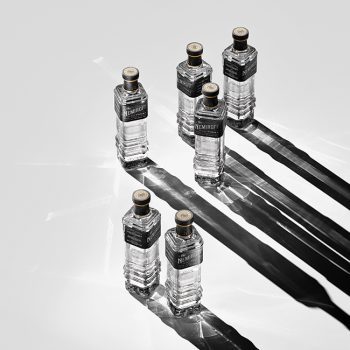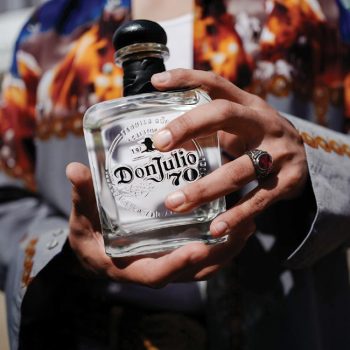How has the war in Ukraine affected spirits?
The spirits industry in Eastern Europe has been enduring a period of instability. We speak to players in the region about the future of the sector there, and looks at how brands have been performing.

*This feature was originally published in the April 2024 issue of The Spirits Business magazine.
What with the war in Ukraine, Covid-19 and, at times, rampant inflation, the spirits market in Eastern Europe has been pretty volatile. “It’s just been an incredible four or five years, and consumers have been moving around,” says Michael Holm, Diageo’s managing director for the region. He admits: “Some have started to trade down, which is not surprising.”
Poland is the region’s leading market, certainly for Scotch whisky, whose shipments to the country were up by 3% in value to £125.6 million (US$159m) last year, but down by 6% in volume to 3.8m cases, which is more than double the next biggest market, Latvia, on 1.8m cases (HMRC). In terms of volatility, “we expect things are going to start to return to normal”, says Holm about Poland. “There is still a lot of price competition, but there always was, and I’m not even sure if it’s been any more fierce lately than it was before.”
The markets he and his team look after all have a dedicated distributor rather than a Diageo-owned company. The same model is used by Beam Suntory, whose area director is Veneta Taneva. Given the surge in the cost of living, she describes the level of discounting as “absolutely logical”, and says: “Central and Eastern European markets were hit with an inflation of 14% in 2022, and even though it dropped to 10%-12% in 2023, it’s still higher than elsewhere. Naturally, that’s the root cause for certain consumer trends, one of which is increased price-consciousness.”
For Taneva: “Poland is 95% off-trade, and 50% of that are the discounters (Aldi and Lidl), so it is quite similar to Germany.” In terms of whisky “our number-one priority in Eastern Europe is Jim Beam”, she says. “It’s already among the top five [whisky] brands, and we put a lot of effort behind it. American whiskeys are increasingly becoming the preferred choice for the consumer.” From this April, Jim Beam’s new global campaign – ‘People Are Good For You’ is being rolled out across the region.
Suntory’s portfolio includes single malts like Bowmore and Laphroaig, while among blends there’s Teacher’s, “and at a more premium level we have Hibiki and Toki”, she says of Beam’s leading Japanese blends. Total whisky was enjoying “double-digit growth until 2022, when we started to see a slowdown”, she explains. “In Poland, the premium end is the only growing price segment, and we’re also noticing that the consumer is going much more to age statements than non-age statements, which is also driven by the fact they’re not so educated about whisky.”
That is one interpretation, though they might simply prefer the reassurance of a number on the label.
Fierce competition
Poland is the biggest market for Ballantine’s Finest, and the brand is the country’s top-selling whisky, according to Fabrice Audan, Pernod Ricard’s CEO for Central & Eastern Europe. With Polish sales of whisky in slight decline, he says: “We’re seeing an intensity of promotions, fierce competition, and a lot of new products limiting the space on shelves.” But, with annual inflation well down from its peak of 18.4% in February 2023, to around 6%, he says: “We’re expecting some light at the end of the tunnel.”
He adds, that with Ballantine’s, “we’ve been extremely successful with some limited editions linked to music stars like AC/DC and Queen”. More will follow, along with the impending launch in the region of Jefferson’s Bourbon and Fuji, the Japanese whisky by Kirin distributed by Pernod. As for general trends, he says: “Value for money is still the most important purchasing driver today. And there’s the trend for RTDs – they’re booming, and they’re growing at double digits.”
For Diageo’s Holm: “Premiumisation is still a trend, even if it has slowed down. We are still seeing ‘premium’ and ‘super-premium’ growing faster than ‘value’ and ‘mainstream’, and we think that will continue.” Diageo’s key brand here is obvious. “Within our entire portfolio in this market, our number-one priority is Johnnie Walker,” he says.
In the company’s interim results for June-December 2023, the brand’s organic sales grew by 12% in Europe, with Johnnie Walker Red Label driving most of the growth, it was reported. In Eastern Europe, the key driver was Black Label “which is now 20% bigger than Red”, claims Holm, thanks to markets like Israel, Bulgaria, and the Balkans. He also mentions that single malts are up by 15% in the region, though he admits: “It’s still only 6% of whisky sales by value.”
Traditionally, by far the region’s biggest market was Russia, whose Scotch imports were worth £183m (US$231m) in 2021, placing it sixth by value in the drink’s export charts. That’s if you include Latvia, where the vast majority of bottled Scotch, destined for Russian consumers, was shipped, strip-stamped and trucked across the border. It appears that about half that trade continues, with the value of Latvian imports of Scotch down to £79m last year from £155m in 2021.
Last summer, Bacardi was labelled an ‘international war sponsor’ by Ukraine’s National Agency for the Prevention of Corruption, for continuing to operate in Russia. It continues to do so. “They use the same warehouses as us in Riga, and we still see goods coming through,” says Holm. “So, as far we know, they are still trading.”
Bacardi declined to comment. But there are certainly others trading there, including Italy’s Campari Group. “We continue distributing Camus in Russia,” says Anne Blois, vice-president of sales at the Cognac house. “A lot of people are, even the people who are not directly selling are still in the market via a different route, via Kazakhstan, Armenia or China. There are no empty shelves in Russia on spirits, and all the categories are there – Cognac, Scotch, Irish whiskey, rum… and Bacardi is at the centre with Martini, which is promoted everywhere. They’re very active in the market.” As for indirect sales or parallel trading, she believes that’s something every brand can control.
Not that it’s easy. “Russia actually used to have extremely effective methods of tackling parallel, and the customs authorities used to be on top of this,” says Holm. “With the war that all changed, and they are now actively encouraging parallel in many categories, including ours. We know there is parallel, we can see it in Russia, but it’s absolutely not something we encourage. It is very hard if you are in the third, fourth or fifth wholesaler, so it can find its way there. We are measuring these things internally, and if we see a spike we can obviously investigate, but we’re not seeing those spikes.”

Russia was the main export market for Ukraine’s Nemiroff vodka, but the company stopped trading there in 2014. For CEO Yuriy Sorochynskiy: “Money is money. Values are completely different.” The focus is on growing exports elsewhere. “Before 2022, we probably had 20% of total sales outside Ukraine,” he says. “By the end of 2023 we had almost double that.” With Russian vodka sanctioned, Nemiroff has found new listings and new distributors.
The distillery in Nemyriv in western Ukraine is being upgraded with a new biomass plant thanks to a €1.3m (US$1.4m) grant approved by the German government late last year. “It’s a very good example of a real project,” says Sorochynskiy, about the way it will make Nemiroff more sustainable, give it energy security in wartime, and help support the country’s economy. He says Nemiroff’s tax receipts put it in the top 50 companies in Ukraine, and it has a workforce of 650, plus around 500 indirectly employed in sales.
Last October it launched ultra-premium vodka Lex by Nemiroff, with an RRP of €80 (US$87), and has been working hard to rebuild the brand in travel retail. In Ukraine, Nemiroff distributes Proximo Spirits, whose brands include Jose Cuervo and Bushmills, which are both enjoying double-digit growth, apparently. As for all the international spirits on Russian shelves, Sorochynskiy shrugs, and points to how even sanctions are not working properly. “Almost every week we receive information in Ukraine that one weapon or another from Russia included components produced in the West,” he says.
Premium rums
Ukraine lies at the end of the so-called ‘rum belt’ that runs through the Czech Republic and Slovakia. Captain Morgan claims to have overtaken Bacardi in the region among imported brands, though “the momentum is more towards the higher-end, premium rums like Don Papa and Zacapa”, says Diageo’s Holm. Its gin stablemates of Gordon’s and Tanqueray are also doing well, mixed with tonic and competing with Aperol for a slice of the apéritif market. “The gin boom is basically over in Western Europe, but in Eastern Europe its still happening,” he claims.

Finally, a word about Tequila, a category “we’re very excited about”, says Holm. “Our priority – Don Julio – was up by 400% last year.” He admits volumes are still very small, but says: “We’re trying to inspire consumers to forget about what they thought they knew about Tequila and relearn, and fall back in love with it. The 100% agave Tequilas we offer are completely different to mixtos.” It is an age-old story for the spirit – to suppress people’s memories of student rocket fuel and wean them onto the good stuff.
Where in the region do you see the most untapped potential for Irish whiskey, and your brands?
Simon Fay – business acceleration director, Irish Distillers
“We believe the potential for growth across all our brands is very positive and, we will continue to deliver quality products and further build on our reputation for excellence globally. Some markets in Eastern Europe are a little further developed, but we believe that there is great potential for our brands.
“One of the key drivers of the success of Jameson in new and emerging markets, aside from the taste and exceptional smoothness, has always been our people. We have Jameson brand ambassadors who work in-market around the world, and they do an incredible job of building brand awareness at a local level, from the ground up, and that work can’t be underestimated. We have ambassadors in markets across Eastern Europe, including Poland, Slovakia, and Czech Republic, who are focused on building our Jameson community. Like any global export business, supply chains and logistics can be a challenge, but we have excellent teams who work closely with our customers to ensure that supply of our whiskeys are where they need to be, and avoid out-of-stock situations.”
How competitive is Eastern Europe when it comes to locally made products and international brands?
Gloria Hallaste – export marketing specialist, Liviko
“The competitiveness of Eastern European products against international brands differs widely. While each country in Eastern Europe has its own unique culture and preferences, they share a common trait: a strong market and traditions for vodka. Countries like Poland lead in both production and consumption within the EU, showcasing a preference for locally made vodkas and spirits. For instance, in Estonia, Liviko liqueurs, vodkas, gins dominate the market already for decades although the market is constantly developing, and new players keep coming. International brands are strong in the categories where Eastern European countries have very little production traditions, such as rum, whisky and brandy.”
Related news
Top 10 spirits for gifting this summer
